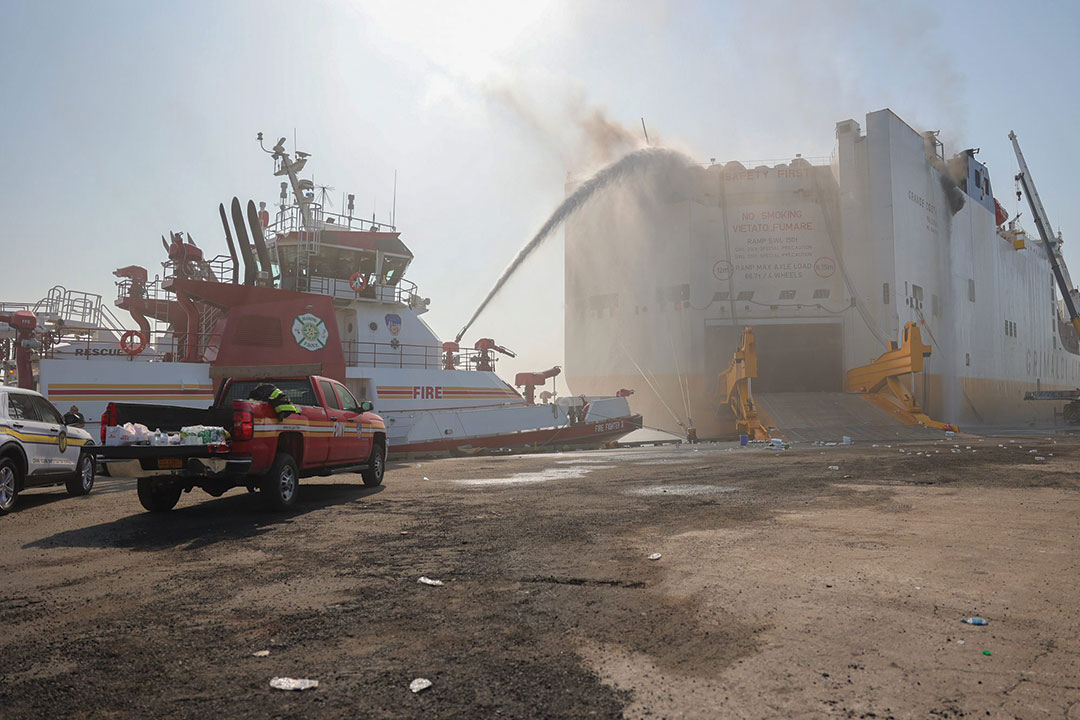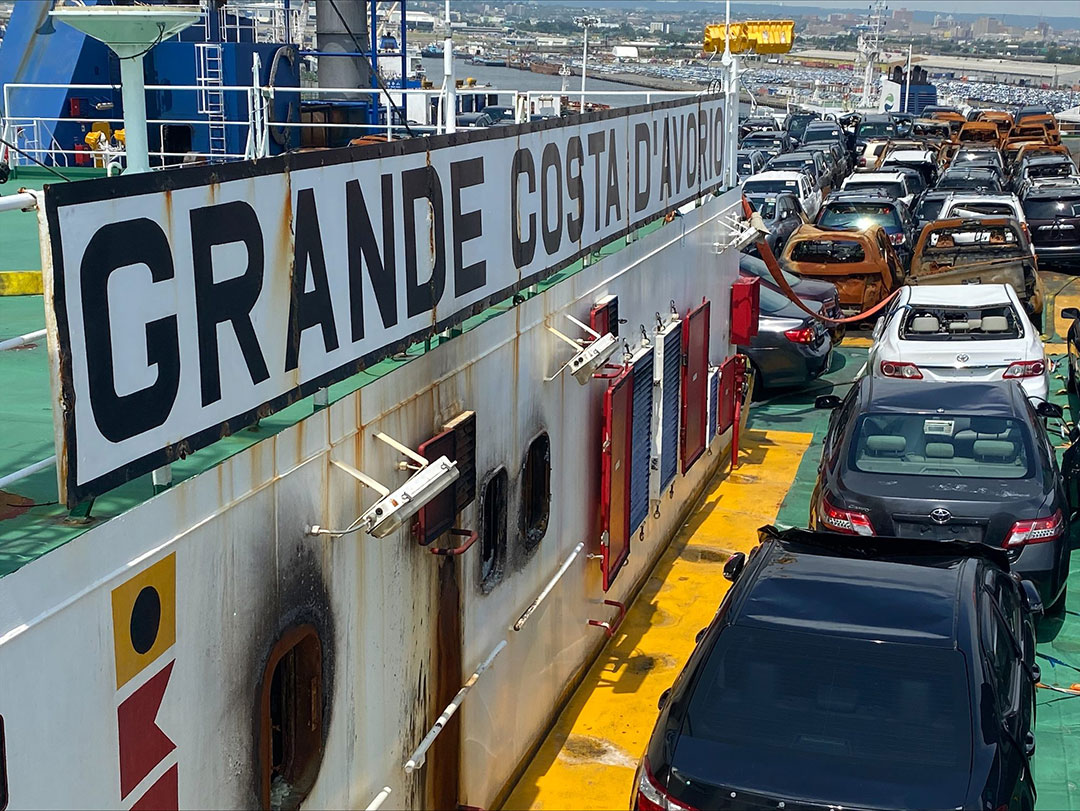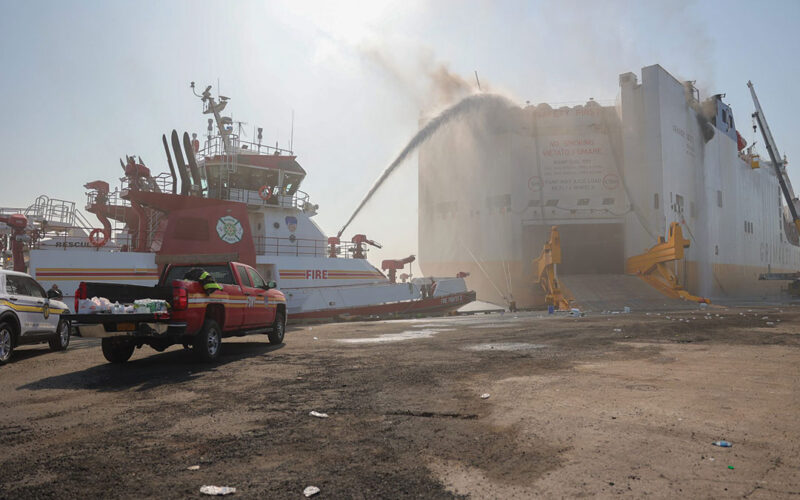
State and federal authorities are working to find the cause of the fatal fire aboard a container roll-on/roll-off ship (con-ro) that started during vehicle loading in Newark, N.J.
The fire aboard the 692-foot Italy-flagged Grande Costa d’Avorio likely started in the No. 10 deck in the ship’s vehicle garage shortly after 9:00 p.m. on July 5 during vehicle loading. The fire spread to other vehicle decks, causing massive damage.
Two Newark firefighters died after becoming trapped inside the burning ship, while at least five other firefighters from Newark and nearby Elizabeth, N.J. were reportedly injured.
The cause of the fire is unknown and likely will remain that way for some time. The Coast Guard is leading an investigation into the incident with the National Transportation Safety Board (NTSB) and state and local authorities.
Italian shipper Grimaldi Deep Sea operates the 12-year-old Grande Costa d’Avorio, which engaged in trade between North America and West Africa. The ship had 1,200 used vehicles and 157 containers on board when the fire broke out.
The company alleges the fire started in a 2007 Jeep used by stevedores to push vehicles onto the ship for export.
“The fire was discovered by the chief officer when he observed the stevedore Jeep tug/pusher coming up the ramp onto the 10th deck while loading vehicles onto the vessel,” said Grimaldi spokesman Jonathan Chia said in an email.
Referring to court papers, Chia stated the Jeep was owned by Ports America and operated by American Maritime Services. Grimaldi asserts the fire in the jeep was the ultimate cause of the fatal blaze on Grande Costa d’Avorio.
“The fire was observed to have started in the Jeep while being used to push another vehicle aboard the ship,” Chia said, adding, “The shipowner is not involved in the maintenance and operation of the tug/pusher vehicles like the 2007 Jeep.”
By press time, Ports America and American Maritime Services had not responded to an inquiry from Professional Mariner.
Grande Costa d’Avorio had a garage on its aft deck for loading vehicles and cargo space forward for loading containerized cargo. The ship arrived at Berth 18 at Port Newark after offloading new electric and gas-powered vehicles in Baltimore, according to Beth Rooney, port director for The Port Authority of New York & New Jersey.

The ship loaded an unknown number of used vehicles in Port Newark that were bound for West Africa after a stop in Providence, R.I., to load additional used vehicles, said Rooney. It is not clear if all vehicles and containers on the ship when the fire started were loaded in Newark.
“What you had inside the holds of the ship where the fire we believe originally started were 1,200 automobiles on nine decks,” Rooney said during the press conference. “What we had burning was components and parts of cars.”
Based on the ship’s manifest, Rooney added, there is no evidence of vehicles containing lithium-ion batteries on board.
The initial emergency call reported six or seven vehicles on fire on Grande Costa d’Avorio’s No. 10 deck. The fire had spread upward to the No. 12 deck by the time firefighters reached the vessel at about 9:25 p.m., according to the Newark Fire Division.
The crew aboard the vessel had already activated the ship’s fixed fire suppression system before firefighters arrived, the Coast Guard said while not elaborating on the type of system installed on the ship or the effects it had on suppressing the fire.
According to a timeline of the incident, Newark firefighters boarded the ship and began firefighting operations soon after arriving. Firefighters broadcast the first mayday at 10:25 p.m. after two firefighters became trapped inside the ship.
Rescue teams were able to reach both firefighters, who were immediately transported to a nearby hospital where they were pronounced dead by medical personnel. Authorities have not disclosed the cause of death for either firefighter or shared details about where they were on the ship and it is unclear as to how they became separated. Several other firefighters were treated for smoke inhalation, heat exhaustion, and burns.
DonJon Smit and Gallagher Marine Systems provided emergency response and salvage services during the fire, while DonJon Smit Project manager, Gordon Lorensen described every shipboard fire as unique, complex, and often extremely hot.
Regarding shipboard fires in general, Smit later commented that, “They are constantly changing and every single one is different. You can do all the training in the world and you are going to find something you have never seen before on a shipboard fire.”
The fire aboard Grande Costa d’Avorio, he added, “is burning very hot so a lot of the decks that are burning and cars burning are inaccessible to fire teams.”
The best situation, he said, “is to cool vessel from the perimeter using fireboats and using hoses from shore to try and keep the fire from spreading,” adding that salvage crews had pumped out the tons of water used to fight the blaze that caused the stricken ship to list.
Five days after the fire broke out, the Coast Guard announced that the fire aboard the Grande Costa d’Avorio was out.
The fire aboard the 692-foot, 47,218 grt. ship started nearly three years to the day Höegh Xiamen caught fire in Jacksonville, Fla., in an incident that left nine firefighters hurt. The Norway-flagged ship was under charter to Grimaldi Deep Sea at the time.
NTSB investigators ultimately determined in a 2021 report that the July 2, 2020, fire likely started from an electrical fault from an improperly disconnected or secured battery on a used vehicle. The agency further found that stevedores provided by SSA Atlantic to load vehicles onto the ship did not follow Grimaldi’s procedures to ensure vehicle batteries were properly disconnected and secured.
“The probable cause of the fire aboard the vehicle carrier Höegh Xiamen was Grimaldi’s and SSA Atlantic’s ineffective oversight of longshoremen, which did not identify that Grimaldi’s vehicle battery securement procedures were not being followed,” the NTSB said at the time.
Chia said Grimaldi expects its contractors to follow “the best practices of their trade.”
“However,” he added, “in this case the batteries in the vehicles coming aboard as cargo were not an issue.”
Grimaldi Deep Sea has launched an internal investigation of the incident. The company acknowledged an official investigation will “clarify the situation” around the cause of the fire.
As of late August, salvage efforts were still underway and Grande Costa d’Avorio remained at Port Newark. Ultimately, Grimaldi Deep Sea said it plans to tow the ship to a shipyard in Europe for what it described as “massive repairs.”

